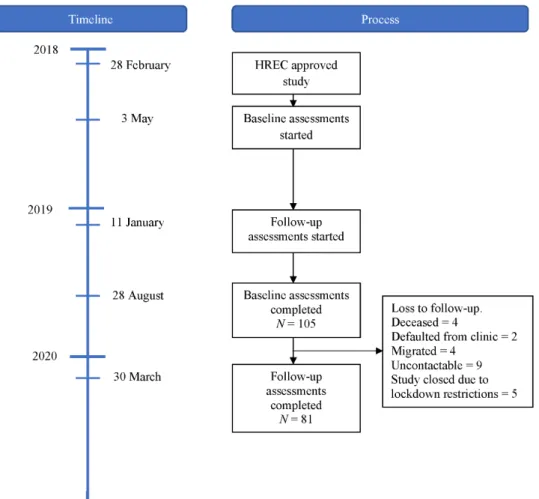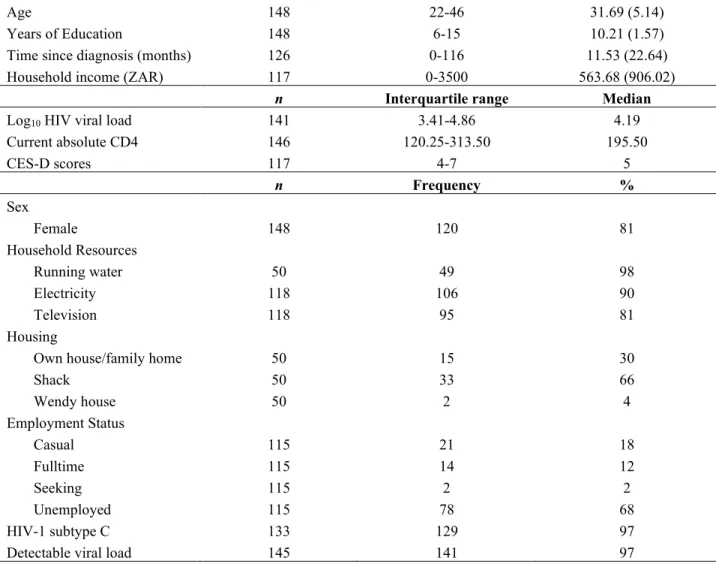Gender differences in cognitive performance in a South African cohort of people with HIV and comorbid major depressive disorder (submitted to Journal of the International Association of Providers of AIDS Care). Cognitive performance in a South African cohort of people with HIV and comorbid major depressive disorder. Some additional support came from a supplemental grant to investigate gender differences in cognitive performance in people with HIV under grant number 5R01MH103770-S1.
Another uncertainty in the HIV neuropsychology literature concerns gender differences in the cognitive performance of PWH. This study investigated which sociodemographic, psychosocial, psychiatric, and medical variables (as measured at baseline) were associated with baseline cognitive performance. Mixed-effects regression models assessed the association between ART adherence (as measured by both self-report and objective measures, and HIV suppression rate) with cognitive performance.
In addition, a label of HIV-associated cognitive impairment may influence self-esteem, confidence, and anxiety about future health in PWH (Alford et al., 2022). Greater cognitive impairment is associated with poorer adherence to cART and poorer health outcomes (Lovejoy & Suhr, 2009; Sayegh et al., 2016; in Maki et al.'s study of other substance use) were significantly higher for MWH than for WWH.
The MWH in the study by Kabuba et al. 2016) samples were significantly older, while WWH in the study by Maki et al. For example, according to Sundermann et al. 2018), adjusted for the significant difference in reading level between WWH and MWH, their analyzes no longer detected significant gender differences in cognitive impairment. For the psychomotor area, Behrman-Lay et al. 2016) used the Grooved Pegboard Test (non-dominant hand), whereas other studies used the Grooved Pegboard Test (dominant hand).
Only in Maki et al. 2018) sample, a greater proportion of MWH and men without HIV were depressed. For example, Kabuba et al. 2016) reported that their WWH had higher current CD4 counts than their MWH.

A recent meta-analysis of six studies in this literature (Dreyer et al., 2022a) found small performance differences between WWH and MWH in three specific cognitive domains. Significant gender differences in cognitive performance may also be explained (at least in part) by gender-based variation in sociodemographic and psychiatric characteristics, such as educational attainment and presence/severity of depressive symptomatology (Donne et al., 2022). For example, Sundermann et al (2018) found that statistically significant gender differences in global cognitive performance no longer existed after analyzes were adjusted for lower reading levels in WWH.
The Enjoyment and Satisfaction in Quality of Life Questionnaire (Q-LES-Q; Endicott et al., 1993) assessed general satisfaction with the quality of daily life. The SF-21 (Wu et al., 1997) assessed health-related quality of life (asking, for example, whether health interferes with or limits physical, social, or cognitive functioning and emotional well-being). Blood samples were collected if participants had not completed recent (1-month) testing (see Joska et al., 2020 for further details).
The Hamilton Rating Scale for Depression (HAM-D; Hamilton, 1960; Williams et al., 2008) was used to assess depression severity. A similar analysis performed on the entire sample is presented in another manuscript (Dreyer et al., 2022b). For example, socioeconomic status (which, especially in LMICs, is much more likely to be lower in women than in men) has been more strongly associated with health-related quality of life than factors of disease (Vidrine et al., 2005).
Low education and illiteracy are both well-established predictors of cognitive performance in the general population (Lenehan et al., 2015; Strauss et al., 2006). In the HIV literature, the WIHS (one of the largest WWH neuropsychology studies) found that years of education and reading level were strong predictors of cognitive performance; in fact, reading level was the strongest such predictor, even surpassing the influence of HIV disease variables (Maki et al., 2015). A South African study found similar results: Educational attainment and cognitive reserve were the only factors consistently associated with cognitive performance in PWH from disadvantaged socioeconomic backgrounds (Narsi et al., 2021).
Fourth, Nadir CD4 count, considered one of the strongest predictors of cognitive impairment (Ellis et al., 2011) was self-reported by participants in this study.
There is wide variation in the reported prevalence of cognitive impairment in people with HIV (PWH). Of interest here, however, is the variation due to differences between the actual criteria used to define cognitive impairment in PWH. Another source of variation in estimated rates of cognitive impairment in PWH is that many of the classification criteria can be applied to cognitive test scores in different ways.
A search of the HIV literature identified eight different sets of criteria used to define cognitive impairment in PWH. Cognitive impairment is indicated if there is impaired test performance in two or more separate cognitive domains. 2015) Cognitive impairment is indicated if: Wright et al. a) performance on a single test is ≥ 1 SD below the normative mean, or. b) each mean domain T-score (calculated by averaging all test scores within a domain) is ≥ 1.5 SD below the normative mean.
Application of the different methods (expecting MNC and NMM) to define cognitive impairment was performed in Microsoft Excel. Light gray bars are methods where criteria for cognitive impairment are applied across mean domain T-scores. Volumetric data: Results from the logistic regression models for the 20 methods of defining cognitive impairment (N = 148).
We identified, after a thorough literature search, eight different sets of criteria used by research studies to define cognitive impairment in PWH. Criteria for defining cognitive impairment in PWH (and/or applications of methods within these criteria) that lead to high rate calculations risk overestimating the extent of the problem, leading to the potential for unnecessary anxiety and stigma (Nightingale et al., 2014). Calculating domain T-scores (or domain z-scores) before applying the method to determine cognitive impairment is also more common in the literature and has been recommended as a better approach (Meyer et al., 2013).
Numerous previous studies have established that cognitive impairment in PWH may be multifactorial (Ciccarelli, 2019; Torti et al., 2011).

Those who were not virally suppressed (HIV RNA viral load > 400 copies/mL) at baseline (n = 72) were part of the sample of a large randomized controlled trial of a cognitive-behavioral treatment for adherence to ART and depression (CBT-AD; Joska et al., 2020; Safren et al., 2021). This test battery has demonstrated adequate psychometric properties in this setting (Joska et al., 2011; Nyamayaro et al., 2020). Measurements of psychosocial and socio-economic variables. The Quality of Life and Satisfaction Questionnaire (Q-LES-Q; Endicott et al., 1993) was assessed.
The SF-21 (Wu et al., 1997) assessed health-related quality of life (ie, related to physical, social, and cognitive functioning and emotional well-being). Categories for food insecurity (food insecure/mildly food insecure/moderately food insecure/highly food insecure) and the prevalence of different levels of food insecurity in households were calculated using equations from the HFIAS Guide, v.3 (Coates et al., 2007). The majority of participants were female, statistically representative of the South African PWH population (George et al., 2019).
This is despite the fact that food insecurity in LMICs is a significant problem (Crush et al., 2012). Beyond the obvious physical health implications, food insecurity has been associated with cognitive impairment (Gao et al., 2009; Koyanagi et al., 2019). Despite high reports of food insecurity in LMIC resident PWH (Anema et al., 2009), there are no studies that have investigated the relationship between food insecurity and cognitive performance among PWH.
With regard to associations between cognitive performance and depression, our analyzes suggested that higher HAM-D scores (indicating greater depression severity) were associated with weaker attention/working memory performance at baseline, when mean HAM-D The sample's D score fell into the severely reduced range (Zimmerman et al., 2013). In addition, the relationship between depression and cognition may be different in PWH with a confirmed current diagnosis of MDD, compared to those experiencing depressive symptoms (Cysique et al., 2016). Gender differences (Dreyer et al., 2021a; Rubin et al., 2019) and socioeconomic hardship (Watson et al., 2019) may also play a role in the relationship between depression and cognitive performance in PWH.
Although the treatment was more effective than standard of care in alleviating depressive symptomatology (confirming results from the primary outcome document; Safren et al., 2021), this improvement did not generalize to cognitive performance.

The literature further suggests that there are independent associations between cognitive performance and ART adherence in the general population of PWH (Sayegh et al., 2016). However, it is worth noting that studies conducted in South Africa have found that women are likely to have better ART adherence than men (Joseph Davey et al., 2018; Pillay et al., 2020). Objective measures, which are considered more accurate than self-report (Spinelli et al., 2020), include real-time electronic medication monitoring of pill taking.
Various forms of Medication Event Monitoring System (MEMS) technology have been developed to measure adherence (Kerr et al., 2005). Africa, TFV-DP is a particularly useful measure of compliance in this context (Jennings et al., 2022). They also completed the Food Insecurity Access Scale (HFIAS; Coates et al., 2007), which measures household food insecurity.
We used the Alcohol Use Disorders Identification Test (AUDIT; Saunders et al., 1993) to identify high-risk alcohol use. This is the standard cut-off value suggested by the World Health Organization (WHO) and suggests probable alcohol dependence (Babor et al., 1992). We used the Hamilton Rating Scale for Depression (HAM-D; Hamilton, 1960; Williams et al., 2008) to assess the severity of depression.
An Intraclass Correlation Coefficient (ICC) > 0.10 was considered high and indicated that a multilevel analysis was relevant (Musca et al., 2011). Most participants were female, which is typical of the South African PWH population (George et al., 2019). All participants had a primary diagnosis of current MDD and the mean HAM-D score was within the range of 'major depression' (Zimmerman et al., 2013) at baseline.
This finding is consistent with other South African studies suggesting that women have better ART adherence than men (Heestermans et al., 2016; Joseph Davey et al., 2018; Pillay et al., 2020).